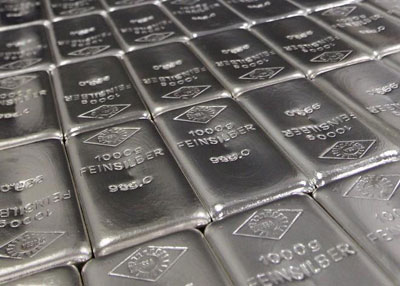Silver fix ends after 120 years
Truth in Gold
 It was born in the late 19th century when a handful of London bullion dealers agreed to meet daily under a cloud of cigar smoke to set the price for the "devil's metal". But now, after 117 years of operation, the London silver fix – an integral part of the city's $1.6tn-a-year silver market – is on its deathbed. It was born in the late 19th century when a handful of London bullion dealers agreed to meet daily under a cloud of cigar smoke to set the price for the "devil's metal". But now, after 117 years of operation, the London silver fix – an integral part of the city's $1.6tn-a-year silver market – is on its deathbed.
The three banks that arrange silver's global benchmark said on Wednesday that prices would be "fixed" for the final time at noon on August 14. The move comes on the heels of increased scrutiny by European and US regulators into precious metals price-setting following the Libor scandal and probe into possible forex market abuse
Deutsche Bank last month resigned its seats on the silver and gold fixes, after failing to find buyers, leaving just HSBC and Bank of Nova Scotia on the silver fix.
The three banks said there would be discussions "to explore whether the market wishes to develop an alternative" to the benchmark. Reference prices could be derived from the futures or over-the-counter silver markets, while the London Metal Exchange, which previously offered silver contracts, could also step in.
Market participants said the fixing process, which occurs via teleconference and allows miners, financial institutions and jewellers to trade silver and value their stocks and contracts, could not function properly with fewer than three members. The UK's Financial Conduct Authority asked Deutsche Bank to stay on for an extra three months to allow for the benchmark to be wound down smoothly.
"Deutsche Bank has postponed its resignation from the London Silver Market Fixing from 29 April 2014 to 14 August 2014, at which point the benchmark will terminate," the bank said on Wednesday.
The regulatory attention has removed the lustre from the once prestigious precious metals fixes, while legal action in the US has been an additional deterrent for potential new members. US lawyers have filed at least 20 class lawsuits alleging manipulation by the banks responsible for the gold fix. Claims of abuse by bankers in the silver futures market led to a five-year probe by the US Commodity Futures Trading Commission, which last year found no evidence of wrongdoing.
The demise of the silver fix will raise questions about the future of the other precious metals benchmarks – platinum, palladium and, especially, gold. Following Deutsche Bank's withdrawal, the gold fix can continue to operate effectively with four member banks, but critics say the process is old-fashioned and opaque, and needs to be overhauled.
"There will now be pressure on the gold fix to make clear its utility," said Brian Lucey, a professor of finance at Trinity College, Dublin. "If one fix can go, why not another?"
truthingold.com |




